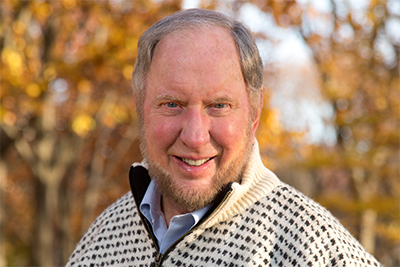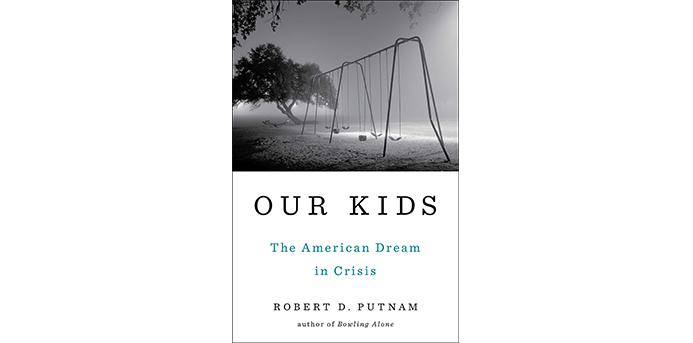Robert Putnam admits good things have happened over the past 30 to 40 years in America — strides in gender equity, moves in the right direction on racial issues — but he’s not here to talk about what’s good. The political scientist and professor of public policy at Harvard University is at the front of a crowded auditorium on a Friday night in Evanston to talk about how things have gotten worse. Specifically, he’s here to discuss the widening social and economic gap between classes in our nation. Luckily, he also has some ideas about how we can go about closing it.

To provide the problem’s scale, Putnam gestures to the far end of the stage and says, “If we were to line up Americans here from the most affluent all the way to homeless — folks on the one end have had a great run for 30 to 40 years while at the other end, they haven’t had a raise in that long.” There are numerous reasons for the gap, but accelerating the problem is our nation’s loss of mixed communities.
“The wealthy live in wealthy enclaves with others of similar status while the poor live with more poor. As a result, fewer and fewer kids across America are going to school with kids from the other side of the tracks — whichever side you happen to be on. This has powerful implications for the education experience,” says Putnam. He points out that more and more of us are living in affluent neighborhoods and more and more of us are living in poor areas; mixed communities are becoming relics from our more economically integrated past.
Putnam launched a research initiative by a group of experts assembled from a range of relevant fields called Closing the Opportunity Gap Initiative. Their working-group report says, “When low-income children are raised in areas where poverty is concentrated, they are less likely to attend high-quality schools, to breathe clean air, develop a diverse network of resourceful peers and mentors, and to find employment opportunities as they approach early adulthood. A growing evidence base suggests that the impact of concentrated poverty is long-lasting, with consequences that alter the life chances of children and extend across generations.”
Putnam illustrates the evolution of the divide with the story of his own hometown of Port Clinton, Ohio. The town’s population of 5,000 residents, mostly white, has remained about the same since the 1950s. Putnam graduated in the class of 1959. Half of his classmates had parents who never finished high school; their dads worked on the auto parts assembly line or as farmers, fishermen or small businessmen. Putnam has spoken with all surviving members of his class, determining where they’ve ended up. “Eighty percent of us did better than our parents,” he says. “Kids from the ‘wrong’ side of the tracks did just as well as the others — there was virtually no difference. How well we’ve done depended mostly on our God-given gifts and our own hard work but not on how or what our parents did.”
As for Putnam, he went on to meet a young coed from Evanston Township High School, get married and have two kids who both went to Harvard. All of their seven grandchildren are either attending or on their way to America’s best learning institutions.
Meanwhile, Putnam tells the divergent story of a classmate from Port Clinton he calls “Joe,” who decided not to go to college. Joe made a career in a factory earning a high annual income, got married too and had kids who attended Port Clinton High School.
Then a well-worn rust belt story unfolded when the bottom fell out of Port Clinton’s economy and the downtown became littered with broken windows, boarded-up businesses and empty factories. Joe’s kids — never married or steadily employed — also had children. Putnam compares one of his granddaughters, Miriam, with one of Joe’s, who he calls “Mary Sue.” While Miriam studied French architecture and French cuisine, Mary Sue’s life was filled with loneliness, distrust and isolation. Her mom became a stripper and her father took up with a woman who beat her and confined her to her room with baby gates. At 13, Mary Sue delivered a stillborn baby. At 16, she was arrested for distributing marijuana. Her boyfriend burned her arm with cigarettes; another, an older man, suggested he could get her a job as a model in Toledo. Mary Sue posted on Facebook that she’d figured out the solution to her problem that no one loves her: having a baby.
“Miriam and Mary Sue are living in different universes,” says Putnam. “Miriam did one very smart thing — she ‘chose’ college-educated parents in a period when college-educated parents are doing really well and from that flows a completely different future from Mary Sue’s.” The Closing the Opportunity Gap Initiative paper states, “Rich kids and poor kids are growing up in separate and unequal Americas, their fates increasingly and unfairly tied to their ‘choice’ of parents and zip code in which they were born.” Child poverty rates in Port Clinton have climbed to 55 percent; this is what the growing segregation of poverty in America looks like.
Putnam steps back from the narrative to show the scale of the problem with graph after graph showing diverging lines representing our socio-economic classes. One group is rising while the other is declining in areas like “Goodnight Moon Time” (stimulation time for children provided by parents), “Enrichment Expenditures,” which are eight times higher for high-income households, and “Family Dinners,” which happen to predict the lifetime income of children.
The divide doesn’t only harm the poorer communities; it’s bad for everyone. Putnam cites healthcare costs — poor children will be sicker, earlier, more often and worse; criminal justice system fees; and the greatest waste of all — losing the insight of three-quarters of the smartest kids in America. “There are cures for cancer we won’t find, talented engineers who happened to be born in the wrong zip code or to the wrong parents, and so on,” he laments.
But Putnam also has hope. “I’m quite confident we can fix this problem,” he says. “Why am I optimistic? We have been here before.” He’s referring to the 1890 gap between the rich and poor during a period of high immigration (the highest until now), political corruption and social Darwinism. Then, thanks to the photojournalism book “How the Other Half Lives” that exposed the country to the slums of the lower east side of Manhattan and a “young, bold” politician named Teddy Roosevelt, Americans became interested in change.
Putnam shares another example, this time in 1910, when some small Midwest towns, for the first time in rural history, devised the free public high school. It was expensive and required convincing local business owners to in essence pay for other people’s kids to get a secondary education, but they pulled it off. “It was one of the best policy decisions Americans have ever made — and it came from civic innovators,” says Putnam. “It raised the productivity of the labor force and gave us the most educated workforce in the world and in the process transformed America. The idea wasn’t from Washington or Harvard, it was from ordinary people in the Midwest.” Remembering the social change our predecessors effected gives hope that each of us can have a role in the change that needs to happen today. For, as Putnam says, referencing the title of his book, “Our Kids: The American Dream in Crisis,” “These kids are all our kids.”
Robert Putnam spoke for the Family Action Network (FAN) in Evanston in April. The event was not filmed; don’t miss out on any more speakers — visit FAN’s site for a list of upcoming events and to sign up for their e-newsletter.
Want More?
- Have an hour? Watch Putnam’s book talk for The Alma and Joseph Gildenhorn Book Series
- Have a few hours? Read Putnam’s book, “Our Kids: The American Dream in Crisis”
- Have a few more hours? Read the full report, “Closing the Opportunity Gap Initiative”
FAN Annual Sponsors: Martin & Mary L. Boyer Foundation, Compass Health Center, Erikson Institute, Evanston Township High School, Make It Better, Mammal Foundation, New Trier Township High School, Pathways, Tina & Byron Trott
FAN Strategic Partners: Acclaim Media, Center for Talent Development at Northwestern University, Curt’s Cafe, Evanston/Skokie School District 65, Hackstudio, Loyola University Chicago School of Law, Master of Science in Education Program at Northwestern University, North Shore Community Bank & Trust, Northern Suburban Special Education District, New Trier Parent Association, Northwestern University, Redefined Fitness, The Book Stall, The Family Institute at Northwestern University, Y.O.U., YWCA Evanston/North Shore
FAN In-Kind Sponsors: Kirkland & Ellis, Turing Group
More from Make It Better:

